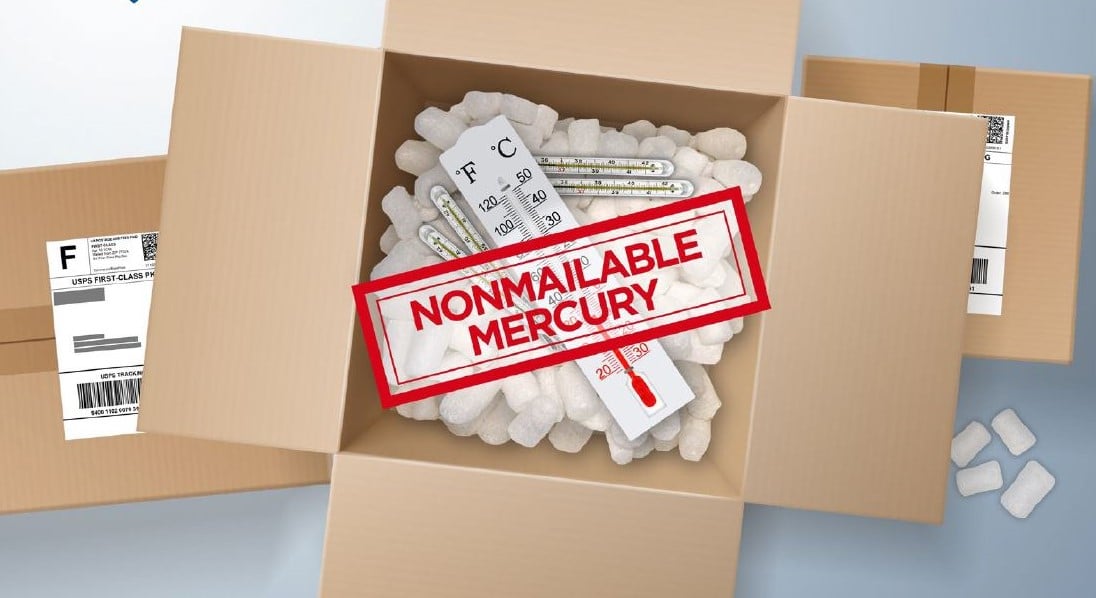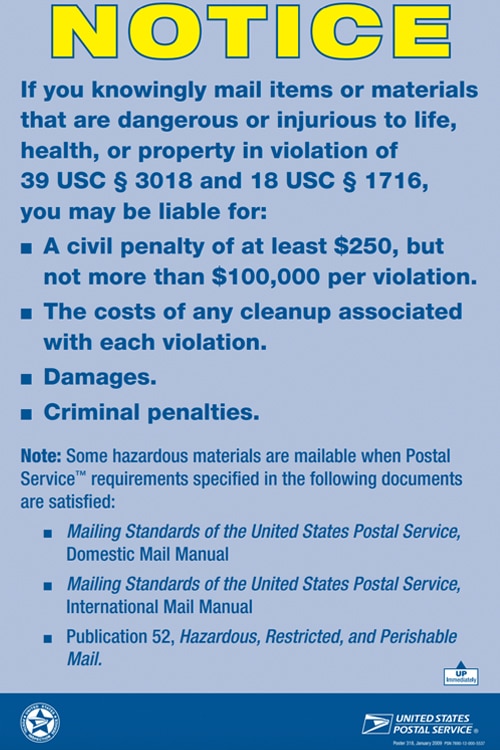
Correction 7/27/2023: Don’t Mail Mercury
The article titled “Don’t Mail Mercury,” published in Postal Bulletin 22268 (7-13-23, pages 33–34), contained incorrect information regarding the international mailability of compact fluorescent lamps.
Compact fluorescent lamps are prohibited to international destinations. The corrected information is shown in bold:
|
Compact fluorescent lamps contain small amounts of mercury vapor. If broken, there will be no visible mercury and the vapors will readily disperse. |
Domestic Ground – Mailable Domestic Air – Mailable International – Prohibited Mailable per section 348.22g of Publication 52, Hazardous, Restricted, and Perishable Mail. See also Packaging Instruction 8C. |
June 29, 2023
WASHINGTON — The Postal Service is reminding customers that metallic mercury and devices containing metallic mercury are always prohibited in the mail stream. This includes antique items such as thermometers, barometers, blood pressure monitors and similar devices. However, compact fluorescent lamps, which contain small amounts of mercury in vapor form, are mailable domestically but not internationally.
Here’s what you should do:
- Review USPS Publication 52, Hazardous, Restricted, & Perishable Mail, to find out if your item is mailable.
- Follow U.S. laws and U.S. Postal Service hazmat guidelines.
- Ship items securely with required labels and markings. Customers can take their package to a Post Office location to make sure it is labeled correctly.
Improper, undeclared, or prohibited hazmat (hazardous material) shipping can have serious consequences for everyone involved.
Full responsibility rests with the mailer to comply with all Postal Service and non–Postal Service laws and regulations in the mailing of hazardous material. Anyone who mails, or causes to be mailed, a nonmailable or improperly packaged hazardous material can be subject to legal penalties (i.e., fines and/or imprisonment), including but not limited to, those specified in 18 U.S.C. The transport of hazardous materials prior to entry as U.S. Mail and after receipt from the Postal Service is subject to Department of Transportation regulations.
If a person knowingly mails items or materials that are dangerous or injurious to life, health, or property, they may face a civil penalty of at least $250, but not more than $100,000 per violation, the costs of any cleanup associated with each violation, and damages. They may also face criminal penalties.
The Postal Service is committed to the safety and security of its employees, its customers, and its transportation networks and will remain vigilant in safeguarding the mail stream against any article that might pose a hazard to health, safety, property, or the environment.
Reminder: Effective July 9, USPS will require Electronic Indicators when shipping Hazardous Materials (HAZMAT) and Dangerous Goods (DG). Publication 52, Hazardous, Restricted, and Perishable Mail (Pub 52) will be revised to incorporate new requirements for mailers to use unique Service Type Codes (STCs) and extra service codes (ESCs) within the tracking barcodes and electronic data submission for package shipments containing HAZMAT or DG.
Additional tools: Tutorial on sending hazardous materials: Hazmat Shipping Safety
Public service announcement on mercury: https://www.youtube.com/watch?v=wriu99Z01r8
USPS News Release – June 29, 2023

Source: USPS

